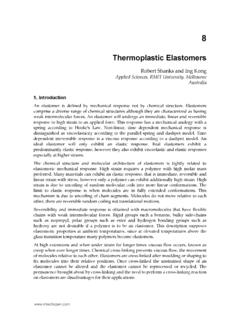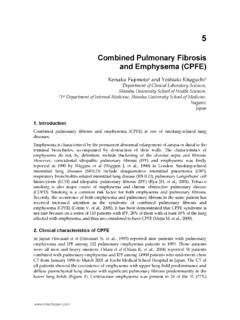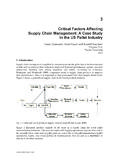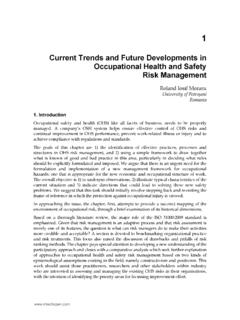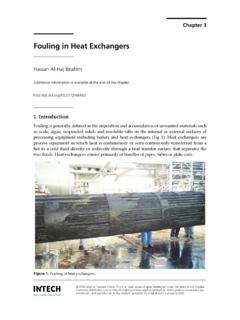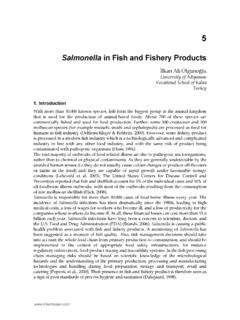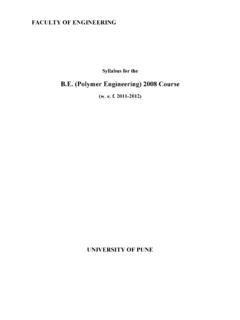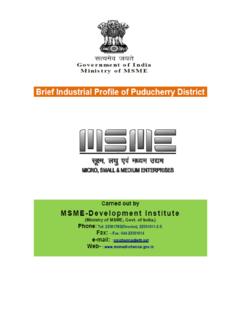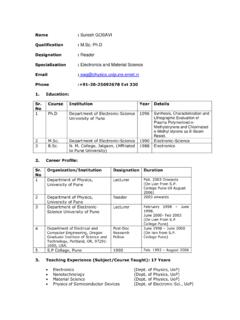Transcription of Photocrosslinkable Polymers for Biomedical Applications
1 3. Photocrosslinkable Polymers for Biomedical Applications P. Ferreira, J. F. J. Coelho, J. F. Almeida and M. H. Gil Chemical engineering Department, University of Coimbra Portugal 1. Introduction Photopolymerization techniques provide a number of economic advantages over the usual thermal techniques. These include: rapid cure reaction, low energy requirements, use of room temperature and solvent free formulations as well as low cost. Light beams are used to start the photochemical reactions in organic materials (monomers, oligomers, Polymers ) to form a new polymeric system This technique allows us to prepare materials with several Applications in industry (UV curable inks, printing plates and adhesives, among others). Photopolymerization has also been used in electronic materials, optical materials, membranes, coatings and surface modifications.
2 The efficiency of the polymerization reaction is dependent on the monomers, the photoinitiator and the beam wavelength. More recently, this technique has been used in the preparation of biomaterials with Applications in important areas as tissue engineering , (Nguyen & West, 2002), biosensors, (Alves et al., 2009), development of drug delivery systems (Rydhholm et al., 2007) dental restorations in situ (Gatti et al. 2007)) and surface modifications to control the materials cell adhesion (Alves et al., 2011). Photopolymerizable Polymers have found numerous Applications in the field of tissue engineering for the engineering of tissues as bone, cartilage and liver (Ifkovits & Burdick, 2007) as they may be photopolymerized in vivo and in vitro. Here we will report some of the literature scientific reports in this field. Ortega and co-workers (2008) showed that the photopolymerization kinetics as well as the resulting structure of the methacrylate based structures are influenced by the monomers and oligomers properties, the reaction conditions, light intensity, reaction temperature and type of photoinitiator.
3 Gatti et al. (2007) referred that photopolymers have been widely used in several dentistry Applications . Different monomers have been used for this purpose. Gatti et al. (2007). prepared and characterized copolymers obtained from bisphenylglycidyl dimethacrylate, triethylene glycol dimethacrylate and urethane dimethacrylate. These copolymers were used to obtain dentistry resins. The kinetic parameters of the reaction were evaluated by using photocalorimetry As it is well known, hydrogels are three-dimensional, hydrophilic, polymeric networks capable of imbibing large amounts of water or biological fluids. They represent an important class of materials to be applied in biotechnology and medicine. These networks have been used as membranes for separating solutes, wound dressings, delivery systems for gene therapy and protein controlled-released systems.
4 Hydrogels have also been applied as 56 Biomedical engineering Frontiers and Challenges bioadhesives, for immobilization of enzymes and cells and in tissue engineering . These photocrosslinked Polymers can be obtained either from natural Polymers (eg. hyaluronic acid) or from synthetic monomers in the presence of a photoinitiator, using visible or ultraviolet light (Nguyen & West, 2002). Tai et al. (2009) prepared and characterized photocrosslinked hydrogels from synthetic monomers to be used as advanced injectable biomaterials. They observed that the PEGMEMA-PPGMA-EGDMA copolymers, with both thermoresponsive and Photocrosslinkable properties, have excellent mechanical properties above the LCST. They suggested that the biodegradability of these gels could be increased by copolymerization with biodegradable blocks. Other authors (Seiffert et al.)
5 , 2007) prepared hydrogels by crosslinking a dimethylmaleimide functionalized polyacrylamide. They observed that this method could give a very efficient method to synthesize hydrogels in a selective and controlled manner. Tae II Son group developed a visible light-crosslinkable porcine gelatine containing furfuryl groups by using Rose Bengal (4,5,6,7-tetrachloro-2',4',5',7'-tetraio dofluorescein) as a visible light sensitizer. These authors referred that the material could be used in the dental field as well as a visible light induced crossslinkable bioselant. Schuster and co-workers (2009) developed gelatine based photopolymers for bone replacement materials. For this purpose, as a first step, they prepared different methacrylate based gelatine derivatives by reaction of this polymer with glycidylmethacrylate and other acrylate monomers. In this way, they obtained polymerizable gelatin that was polymerized with a polyethyleneglycol monomethacrylate comonomer.
6 They where then, able to prepare cellular structures by using stereolithography. Nichol and colleagues (2010) prepared a photopolymerizable gelatine methacrylate for tissue engineering Applications . They modified gelatine with methacrylic anhydride, which was subsequently photopolymerized with UV irradiation, in the presence of Irgacure 2959. These authors suggested that these hydrogels could be applied in microscale Applications to create endothelial-lined vessels within engineered tissues. Hu and co-workers (2010) used a carboxymethylated chitosan modified with 4- nitrocinnamate acid to obtain a photopolymerizable derivative without initiator. They were able to prepare a gel with good mechanical properties that was efficiently used as a matrix in a drug delivery system. Although the extension of described works, the photopolymerization/photocrosslinkage are processes which are still being studied and therefore explored by many researchers.
7 In this chapter, we wish to report some of the highlights of our work, in this field, still on course in our research group. 2. Photoinitiators The photocrosslinking technology by using ultraviolet (UV) or visible light has been used extensively in several Applications including several types of coatings and Biomedical Applications . When this technology is used in combination with biodegradable Polymers very interesting solutions can be found for drug delivery and tissue engineering Applications . The photoinitiators are one of most important compounds used in the formulation due to its influence on different reaction parameters. The chemical nature of the photoinitiator determines the reaction rate, the spectral sensitivity (wavelength of absorption), the light resistance and the stability of the materials under storage conditions. Photocrosslinkable Polymers for Biomedical Applications 57.
8 In order to obtain crosslinked Polymers , it is necessary to generate free radicals in the system that will induce a free radical chain polymerization of monomers and oligomers. Both have reactive functional groups that can be activated under the presence of reactive radicals, resulting in the formation of crosslinked structures (Corrales et al., 2003). In the mechanism involved in the process we can consider three main reactions: initiation, propagation and termination. Photoinitiators have an essential role in this process, since they are excited under UV radiation leading to the formation of the active radicals that start the polymerization mechanism (initiation). The crosslinking can occur by the reaction of the functional groups that exist in the monomer or polymer structure, which results in a direct intermolecular crosslinking (Figure 1).
9 Fig. 1. Representation of the photopolymerization/photocrosslinking processes (Adapted from Decker, 2002). The crosslinking density plays a critical role in the performance of the biomaterial since it controls properties including permeability, degradation, thermal and mechanic and water uptake (Martens et al., 2003). The use of the proper photoinitiator allows the fine tuning of the reaction rate and therefore the control of the density of crosslinking. We can consider the existence of two basic types of photoinitiators (Allen et al., 1999): Type I, and Type II. Type I photoinitiators when exposed to UV radiation suffer a fragmentation process that origins the formation of the active radicals with the capacity to start the radical polymerization. Examples of such compounds are the acetophenone derivatives and the - hidroxyalkyl phenones. The - hydroxyalkylphenones, as for example 4-(2- hydroxyethylethoxy)-phenyl (2-hydroxy-2-methyl propyl) ketone (Irgacure 2959, Ciba) are extremely reactive and present a high thermal stability.
10 Once irradiated, benzoyl and alkyl radicals are formed and although both radicals are reactive to initiate the polymerization, the benzoyl presents higher reactivity. Type II photoinitators require the presence of molecules, in the system, that suffer a primary process of hydrogen abstraction. These molecules are often referred as co-initiators and are usually tertiary amines. The reaction starts with the formation of the intermediary species resulting from the interaction between the amine and the photoinitiator carbonyl group. The 58 Biomedical engineering Frontiers and Challenges process continues with an electron and a hydrogen transfer resulting in the radical formation. When Biomedical Applications are concerned, the biocompatibility of the photoinitiator is a critical issue to be considered. Williams and co-authors have studied the biocompatibility of the three different photoinitiators (2-hidroxy-1-[4-(2-hidroxyethoxy)phenyl] -2-methyl-1- propanone (Irgacure 2959); 1-hidroxycyclohexyl-1-phenyl ketone (Irgacure 184) and 2,2- dimethoxy-2-phenylacetophenone (Irgacure 651)) commonly used in the preparation of biomaterials using six cellular lines (Williams et al.)


